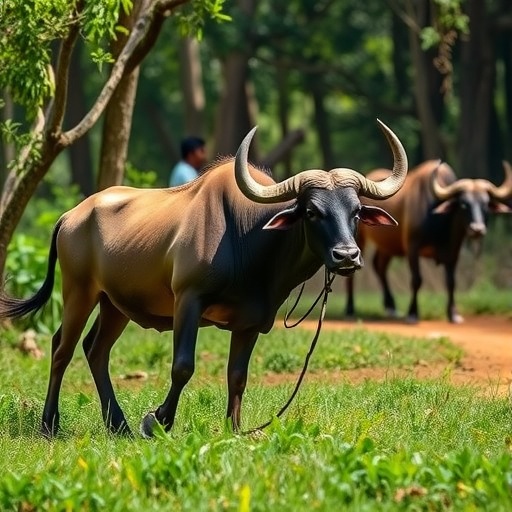In the diverse ecosystems of Tamil Nadu, a complex narrative unfolds regarding the interactions between humans and one of India’s most majestic mammals, the gaur. The recent research conducted by a team led by T.T. Shameer explores the intricate dynamics that fuel human-gaur conflict across various landscapes in this region. The research examines how ecological and temporal factors uniquely influence these interactions, revealing vital insights into wildlife conservation and human-animal coexistence.
Gaur, also known as the Indian bison, is the largest species of wild cattle and holds a significant place in the biodiversity of Tamil Nadu. This keystone species plays a crucial role in maintaining ecological balance by influencing vegetation and habitat dynamics. However, as human populations expand and agricultural practices intensify, conflicts with this magnificent beast have increased. This escalation in encounters raises urgent questions about wildlife management and conservation strategies in rapidly changing landscapes.
The researchers utilized a combination of ecological data analysis and field surveys to dissect the factors that contribute to human-gaur conflicts. They collected data on guard movements, habitat preferences, and human activities, unveiling a tapestry of interactions that shift with the seasons and human engagements. Such interdisciplinary approaches enrich our understanding of wildlife behavior and inform effective management practices that can balance human needs and wildlife conservation.
Temporal factors were highlighted as particularly influential in the study. Seasonal changes in agriculture and local environmental conditions have a profound impact on gaur behavior and habitat use. For instance, during the harvest season, gaurs are more likely to stray into agricultural fields searching for food, leading to heightened conflicts. The research emphasizes the necessity for local communities to adapt their practices and for policymakers to take these temporal dynamics into account when formulating conservation strategies.
Another vital element identified in the study was the ecological context. Various habitats in Tamil Nadu—ranging from dense forests to agricultural landscapes—affect human-gaur interactions in different ways. The research highlights how fragmented habitats can exacerbate conflicts, as gaurs navigate between safe spaces and human-dominated areas. This closing of natural space demands innovative solutions to ensure that wildlife has safe passages and corridors to thrive.
Human encroachment on natural habitats has profound implications for gor’s survival. The increasing conversion of forest land to agriculture alters the natural landscape, often leading to direct confrontations between humans and wildlife. Understanding these dynamics allows for the crafting of tailored management plans that engage local communities and leverage their knowledge about the land and its inhabitants.
To tackle the rising rates of conflict effectively, the researchers recommend developing comprehensive public awareness campaigns. By informing local communities about the ecological importance of gaurs and the benefits of coexistence, there can be a push toward more harmonious living. Educational programs can also provide practical guidelines for preventing conflicts and managing encounters, empowering communities to take proactive measures.
In addition to public outreach, implementing strategic land-use planning and development policies is crucial. Policymakers need to prioritize the preservation of wildlife habitats while balancing the needs of agriculture. Strategies such as creating buffer zones and promoting organic farming can mitigate human-gaur encounters, fostering an environment where both can flourish.
Technological advancements present an opportunity to enhance conflict mitigation efforts. The integration of remote sensing and wildlife tracking can provide real-time data on gaur movements and activities. Such data can empower local communities and conservationists to anticipate potential conflicts, allowing for timely interventions that protect both the local populace and gaur populations.
The socio-economic dimensions of this issue cannot be overlooked. Many communities rely on agriculture as their primary source of income; therefore, the economic ramifications of crop damage from wildlife can be severe. Government compensation schemes for crop losses can incentivize communities to adopt more wildlife-friendly practices while providing them with the financial support necessary to adapt to the changing dynamics.
As global awareness of biodiversity and conservation escalates, this research underscores the critical need for interdisciplinary collaboration. Conservationists, ecologists, and local communities must work hand in hand to develop solutions that prioritize both human welfare and wildlife conservation. By intertwining traditional ecological knowledge with scientific research, novel approaches can emerge to mitigate conflict and foster coexistence.
The significance of this research extends beyond Tamil Nadu, serving as a model for wildlife conservation efforts in other regions facing similar challenges. By shedding light on the underlying drivers of human-wildlife conflict, the study advocates for proactive approaches that embrace the complexities of nature. As human populations continue to grow, the world must grapple with preserving wildlife while meeting the needs of an expanding global community.
In conclusion, the work conducted by Shameer and colleagues serves as a significant contribution to the understanding of human-gaur interactions, calling for a multifaceted approach that incorporates ecological, temporal, and socio-economic factors. The findings illuminate a path forward, fostering dialogue between stakeholders and promoting collaborative strategies to ensure that the serene presence of the gaur continues to enrich the landscapes of Tamil Nadu.
As we look toward the future, ongoing research and community engagement will be essential for navigating the challenges of human-wildlife coexistence. Ultimately, it is our responsibility to cultivate a world where wildlife and humans can thrive side by side, ensuring a sustainable future for both.
Subject of Research: Human-gaur conflict in Tamil Nadu, India.
Article Title: Ecological and temporal drivers of human-gaur conflict in Tamil Nadu, India.
Article References:
Shameer, T.T., Routray, P., Udhayan, A. et al. Ecological and temporal drivers of human-gaur conflict in Tamil Nadu, India.
Discov Anim 2, 44 (2025). https://doi.org/10.1007/s44338-025-00100-y
Image Credits: AI Generated
DOI: 10.1007/s44338-025-00100-y
Keywords: Human-wildlife conflict, gaur, Tamil Nadu, ecology, conservation, agriculture, biodiversity.




